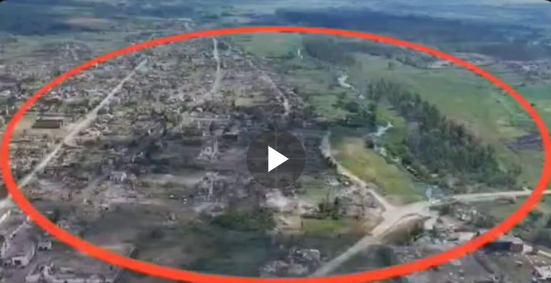With Russian forces still advancing anywhere they want, Ukraine is facing a vicious defeat.
Russian observation drones have been operating freely over the Ukrainian battlefield, calling in artillery, air, and missile strikes without facing significant resistance. Oleksandr Syrsky, commander of the Armed Forces of Ukraine (AFU), revealed this in a statement, noting a severe shortage of handheld anti-aircraft missiles among Ukrainian troops. Syrsky urged his forces to explore new methods to counter these reconnaissance drones, such as enhancing jamming techniques and employing one-way kamikaze drones to intercept them.
On the Vovchansk front, Russian aviation strikes Ukrainian infantry hiding in an abandoned textile factory with FAB bombs. Ukrainian forces regularly use basements of abandoned factories to concentrate assault groups, but this doesn’t guarantee their safety.#Ukraine🇺🇦 #Russia🇷🇺 pic.twitter.com/qhvFOFpVyd
— Chronology (@Chronology22) July 22, 2024
A recent statement from the AFU General Staff indicated that the Russian Air Force set a new record with 132 glider bomb strikes against Ukrainian positions on Monday, primarily supporting their offensive towards Pokrovsk. Russian state media has claimed that these attacks will succeed because Ukrainian forces lack the capability to counter long-range strikes directed by these drones.
Research by the Kyiv Post corroborated that Russian observation drones frequently operate deep behind Ukrainian lines, identifying targets and guiding missile strikes without interference. Over the past two weeks, these drones have recorded and directed attacks on various locations, including Kharkiv, Donetsk, Mykolaiv, Zaporizhzhia, and Odesa. Targets included troop-training bases, airfields, rail hubs, anti-aircraft systems, ammunition storage sites, and equipment warehouses.
In response to the drone threat, some Ukrainian air defenders have taken to the skies themselves, flying single-engine planes and armed with rifles or shotguns to hunt the drones. However, the preferred method remains the use of shoulder-fired anti-aircraft missiles. Supplies of these weapons have dwindled, as major suppliers like the US, Poland, France, and the UK have nearly exhausted their stocks and are struggling to ramp up production. Raytheon, the manufacturer of the Stinger missile, has had to recall retired engineers to restart production lines that were shut down decades ago.
The suicide rate in the Russian army is skyrocketing.
I see dozens of videos of Russian invaders committing suicide in Ukraine to avoid being hit by an FPV kamikaze drone every week.
I wish they killed themselves at home. Why do they keep crossing the border and coming so far? pic.twitter.com/kIOr8axzY7
— BREAKING NEWS: UKRAINE (@MrFukkew) July 23, 2024
Lt. Gen. Syrsky’s comments came after visiting frontline formations in the heavily contested eastern Donbas region. He observed that Russian forces, despite sustaining high casualties, continue their broad-front offensive, attacking multiple towns and villages daily. The primary objective for Russian forces is to capture Pokrovsk, a crucial transportation hub in the Donbas.
Syrsky emphasized the need for Ukrainian troops to stay on the defensive, inflict maximum losses on Russian forces, and minimize their own casualties rather than focus on regaining lost ground. He advised using fortifications, minefields, and FPV kamikaze drones—an area where Ukrainian forces have a clear advantage over their Russian counterparts.
During his visit, Syrsky met with soldiers and commanders of the 47th Mechanized Brigade and the 95th Air Assault Brigade, long-standing units stationed in the Avdiivka/Pokrovsk sector. Russian forces captured Avdiivka in February 2024 and have since pushed 15 kilometers westward amidst heavy combat. Despite losing ground, Syrsky praised the troops for their resilience and handed out medals for valor. He also observed training exercises focused on improving tactical efficiency, stressing the importance of high-quality training for all service members to enhance combat capabilities and reduce losses.
#MilitaryLife #dronewarfareupdate Russian Forces Boost FPV-Drone Tactics: New Challenges for Ukrainian Defenders: Russian Forces Enhance FPV-Drone Capabilities: What Threats Do They Pose to Ukrainian Defenders? Analysts from the Institute for the Study… https://t.co/y7h3Pvzp5C pic.twitter.com/wMRzMErxZc
— militarynews (@militarydefens) July 23, 2024
Syrsky highlighted the need for mastery in weapon and equipment use, effective fire, maneuvering with fire, and the importance of preparing all levels of staff to maximize combat effectiveness and minimize losses.
Major Points:
- Ukrainian forces face significant challenges from Russian observation drones, which operate freely and direct artillery, air, and missile strikes with little interference.
- Oleksandr Syrsky, commander of the Armed Forces of Ukraine, highlighted a severe shortage of handheld anti-aircraft missiles and called for new countermeasures, such as enhanced jamming and kamikaze drones.
- The Russian Air Force recently set a record with 132 glider bomb strikes in one day, targeting Ukrainian positions and supporting the main offensive towards Pokrovsk.
- Research confirmed Russian drones are operating deep behind Ukrainian lines, directing strikes on various strategic targets without opposition.
- Ukrainian forces are advised to focus on defensive tactics, inflicting maximum losses on Russian forces, and using their advantage in FPV kamikaze drones while continuing to train and improve tactical efficiency.
Conner T – Reprinted with permission of Whatfinger News



